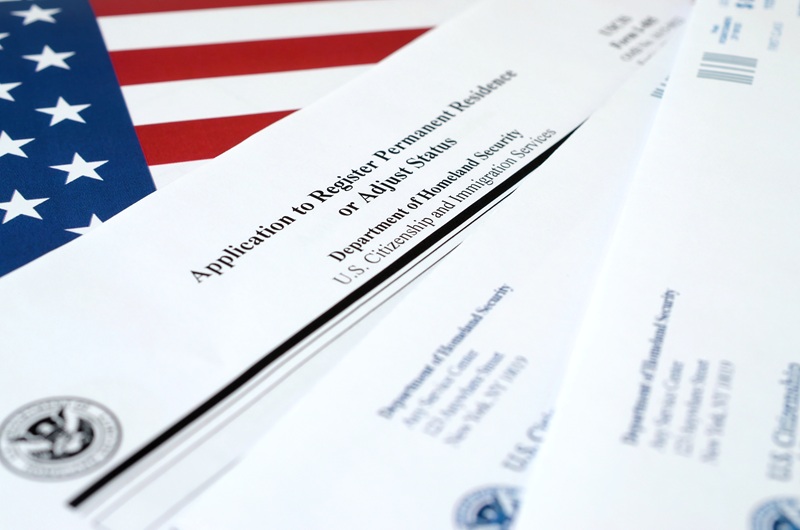Becoming a lawful permanent resident (LPR) is a life-changing step for many immigrants. Immediate relatives of U.S. citizens apply for a green card (or LPR) through Adjustment of Status (AOS) while living in the United States. This process helps families stay together while securing their legal status.
Unlike other visa categories, immediate relatives do not face numerical visa limits. However, the process must follow strict eligibility rules and detailed application steps. Understanding the process avoids delays or denials. This guide explains each step of AOS and how Immigration Lawyer Laredo TX can assist.

Key Points About Adjustment Of Status
AOS allows individuals already in the U.S. to apply for lawful permanent residency or a green card without leaving the country. This immigration pathway benefits those eligible under family-based immigration categories, particularly immediate relatives of U.S. citizens.
The advantage of AOS is that it eliminates the need for consular processing, requiring applicants to return to their home country for visa approval. Instead, they can remain with their families while their application is processed. This is especially true for spouses and children who would otherwise face separation.
Meeting the eligibility requirements is vital for a successful Adjustment of Status application. USCIS sets specific guidelines for immediate relatives seeking lawful permanent residency. Any mistakes or missing documents lead to processing delays or denials.
Understanding the Adjustment of Status is the first step toward obtaining lawful permanent residency. To move forward, applicants must meet specific eligibility requirements based on their relationship to a U.S. citizen.
Eligibility Criteria For Immediate Relatives
The Adjustment of Status process is available only to certain family members of U.S. citizens. Immediate relatives eligible for AOS include:
- Spouses.
- Parents if the petitioner is 21 or older.
- Unmarried children under 21.
Unlike other family-sponsored categories, immediate relatives do not have to wait for visa availability, as there is no annual cap. However, meeting the eligibility requirements is still necessary. One of the critical conditions for AOS eligibility is lawful entry into the U.S..
Lawful entry means the applicant must have entered the country legally using a visa or another approved method. Those who entered without inspection (illegally) may not qualify for AOS unless they qualify for specific waivers.
Immediate relatives who have overstayed a visa or worked without authorization can still apply for AOS, provided they enter the U.S. lawfully. Understanding these requirements is key to ensuring a successful application.
Once eligibility is confirmed, applicants must complete several steps to apply for a green card. Understanding each step of the Adjustment of Status process helps ensure a smooth and timely application.
Step-By-Step Process For Adjustment Of Status
Adjustment of Status allows certain immigrants already in the U.S. to apply for a green card without leaving the country. This process involves submitting applications, attending appointments, and completing an interview with USCIS. Understanding each step helps avoid delays and ensures a smooth experience.
Filing The Immigrant Petition (Form I-130)
The process starts with a U.S. citizen petitioner filing Form I-130, Petition for Alien Relative. This form establishes the family relationship between the petitioner and the applicant. Required documents include proof of U.S. citizenship, such as a birth certificate or passport, and proof of the relationship, such as a marriage or birth certificate. They must include divorce or death certificates if either spouse was previously married.
Immediate relatives can undergo concurrent filing for Form I-130 and Form I-485, allowing the green card process to begin sooner. Once USCIS approves Form I-130, the next step is filing for permanent residency.
Submitting The Adjustment Of Status Application (Form I-485)
After USCIS accepts Form I-130, the applicant submits Form I-485, Application to Register Permanent Residence or Adjust Status. This form requests a green card and must include supporting documents, such as proof of lawful entry into the U.S. (Form I-94), government-issued identification and passport-style photos.
The petitioner must also submit Form I-864, Affidavit of Support, proving they meet financial requirements. A medical examination (Form I-693) from a USCIS-approved doctor must confirm that the applicant meets health-related immigration requirements.
Filing fees apply unless the applicant qualifies for a fee waiver. After submission, USCIS sends a receipt notice, and the case moves forward.
Attending The Biometrics Appointment
USCIS schedules a biometrics appointment at a local Application Support Center (ASC). The applicant provides fingerprints, a photograph, and a digital signature during this appointment. These biometrics allow USCIS to conduct background checks and confirm eligibility.
USCIS sends a notice with the appointment date, time, and location. Applicants must bring a government-issued ID. Missing an appointment without rescheduling can cause delays. Once the biometrics are processed, the case moves toward the interview stage.
Undergoing The Adjustment Of Status Interview
Most applicants must attend an interview at a USCIS office. A USCIS officer will review the application, verify the applicant’s eligibility, and confirm the legitimacy of the family relationship. During the interview, the applicant typically brings the medical examination result.
For spousal applications, the officer may ask questions about how the couple met, their daily routines, and details about their life together. The applicant should bring all original documents, including passports, birth certificates, marriage certificates, and any additional proof of their relationship.
At the end of the interview, the officer may approve the application, request more evidence, or conduct further review. If additional documents are needed, USCIS will issue a Request for Evidence (RFE), which applicants must answer promptly.
Receiving The Decision
After the interview, USCIS will either approve or deny the application. If approved, the applicant will receive an approval notice, followed by a green card in the mail. This card grants lawful permanent residency, allowing them to live and work in the U.S. indefinitely.
If denied, USCIS will provide a notice explaining the reason. Some applicants may be able to appeal or file a motion to reopen the case. Consulting an immigration attorney can help determine the best course of action.
Each stage of the Adjustment of Status process takes time, and applicants must wait for USCIS to review their cases. Understanding typical processing times and potential delays can help families plan accordingly.
Processing Times & Common Delays
The processing time for Adjustment of Status varies depending on the USCIS workload, applicant location, and individual case circumstances. On average, the entire process takes between 8 and 14 months. Some applicants receive approvals sooner, while others may face delays.
Understanding the common causes of delays helps applicants prepare and avoid unnecessary setbacks.
Requests For Evidence (RFEs)
A Request for Evidence (RFE) is a common reason for processing delays. USCIS issues an RFE when an application lacks the required documents or contains incomplete information. It extends the timeline, as applicants must submit additional evidence before USCIS can proceed.
Providing accurate and complete documentation from the beginning helps avoid RFEs and keeps the case moving forward.
Biometrics & Interview Delays
USCIS schedules biometrics appointments and interviews as part of the AOS process. Missing or rescheduling these appointments can cause significant delays. If an applicant does not attend the biometrics appointment, their background check cannot proceed. Similarly, failing to appear for an interview can result in a case being put on hold or even denied.
Background Check Complications
Security checks can extend processing times, particularly if an applicant has a common name or prior immigration violations. Additional screenings may be required, which could cause further delays. Applicants with previous arrests or immigration infractions should provide all relevant documents to clarify their case.
Filing Errors & Application Mistakes

Incorrectly completed forms, missing signatures, and incorrect filing fees can delay processing. If USCIS rejects an application due to errors, the applicant must refile and restart the process. Changes in address without notifying USCIS can also result in missed notices or interview appointments.
Attention to detail ensures that applications move through the system without unnecessary complications. Legal guidance addresses issues promptly and ensures that applicants apply correctly. Lozano Law Firm can assist throughout the entire Adjustment of Status process.
Immigration Lawyer Laredo TX, A Trusted Immigration Partner
At Lozano Law Firm, we provide personalized immigration assistance to Laredo families navigating the Adjustment of Status process. We help immediate relatives secure lawful permanent residency. From the initial petition to the final green card approval, we guide our clients every step of the way.
Our team handles I-130 and I-485 preparation, represents clients during interviews, and responds to RFEs or denials. We file applications correctly to minimize delays and avoid mistakes that could lead to rejections. Our clients receive clear answers to their questions and honest advice about their cases.
For those facing immigration challenges, we offer tailored solutions to fit individual circumstances. Our commitment to keeping families together has made us a reliable choice for immigration services. Those needing professional legal assistance can contact us for guidance and support.
Adjustment of Status allows immediate relatives of U.S. citizens to apply for a green card without leaving the United States. Eligible family members include spouses, parents, and unmarried children under 21. The process involves filing Form I-130 and Form I-485, attending a biometrics appointment, and completing a USCIS interview. If approved, applicants receive a Green Card or permanent resident status.
Processing times range from 8 to 14 months, but delays can occur due to RFEs, missing documents, or background checks. Correct submission of forms helps avoid unnecessary wait times. For those needing legal assistance, Lozano Law Firm provides reliable immigration services. Our team helps applicants complete the Adjustment of Status process smoothly and efficiently.



